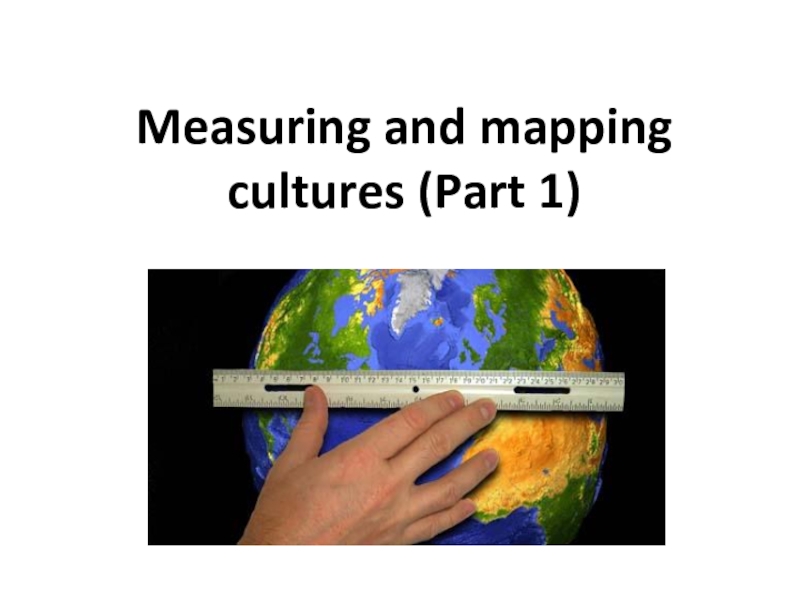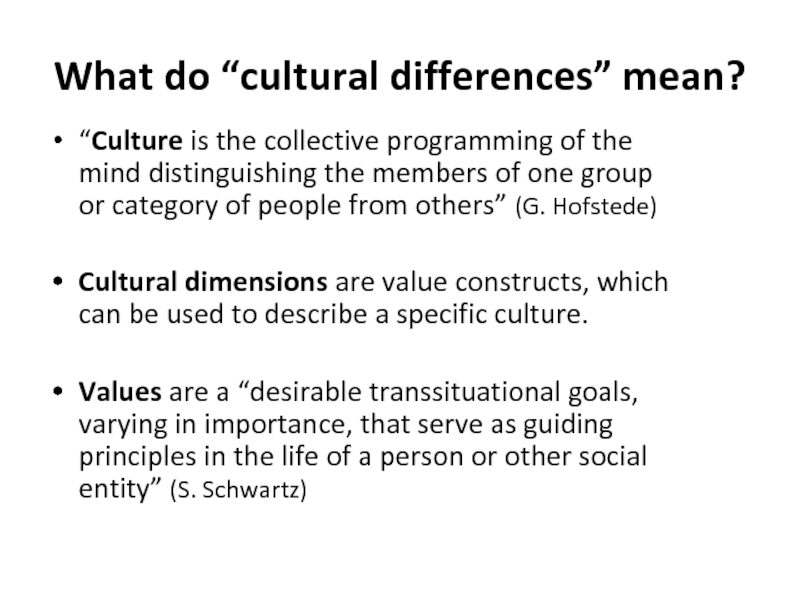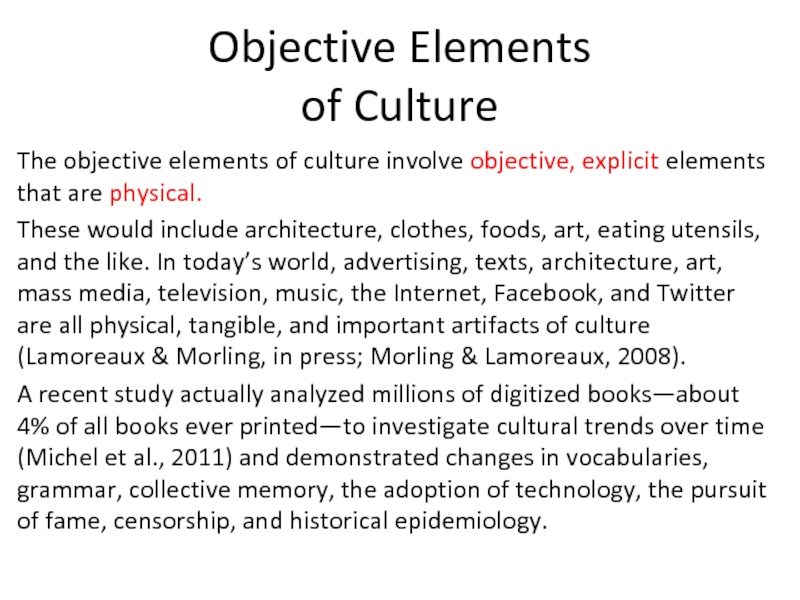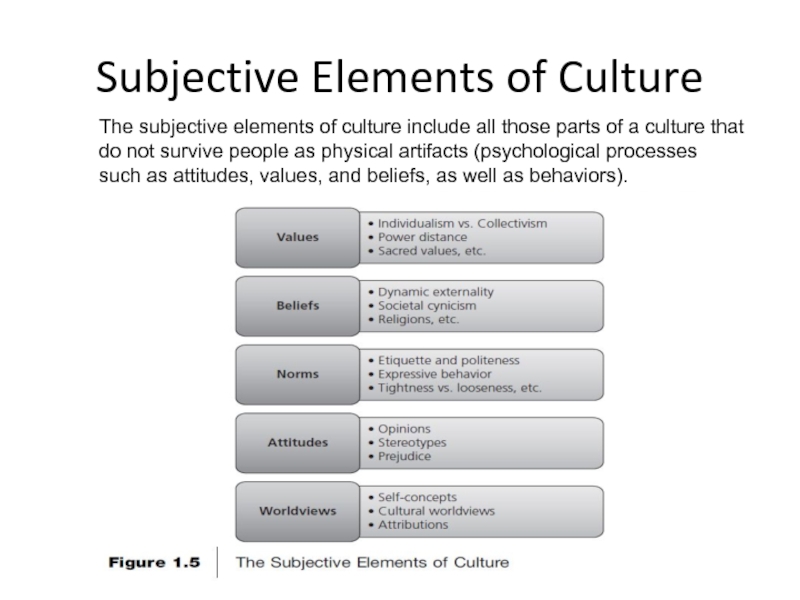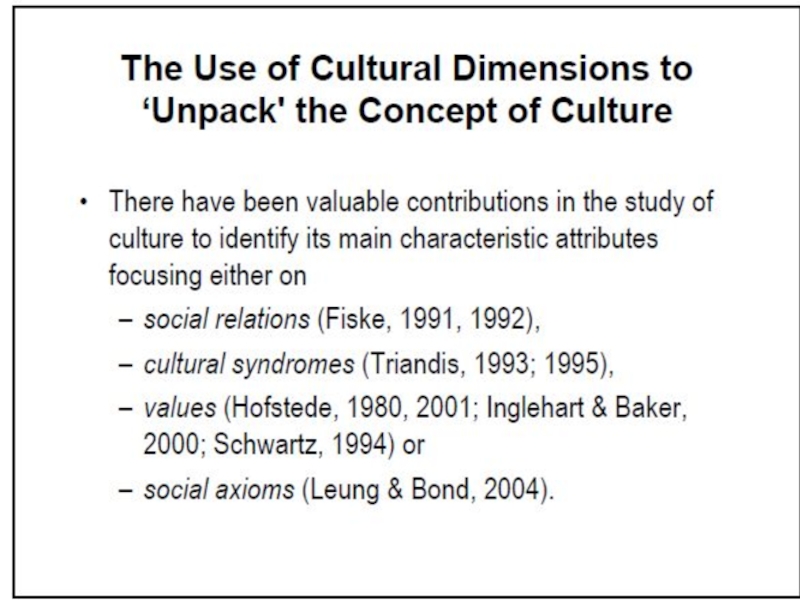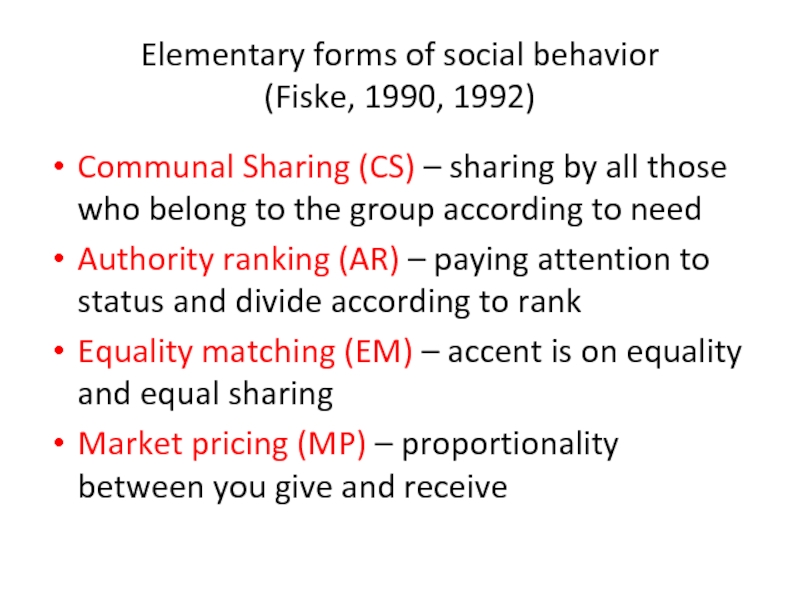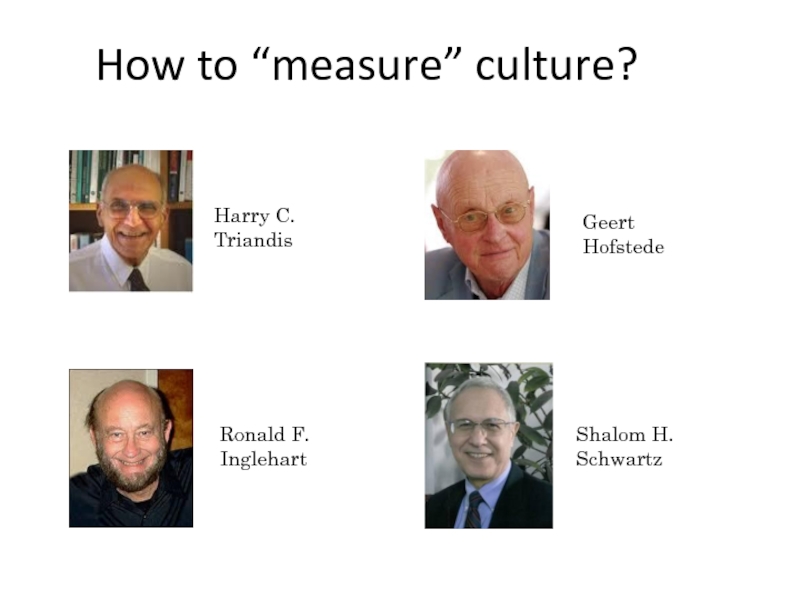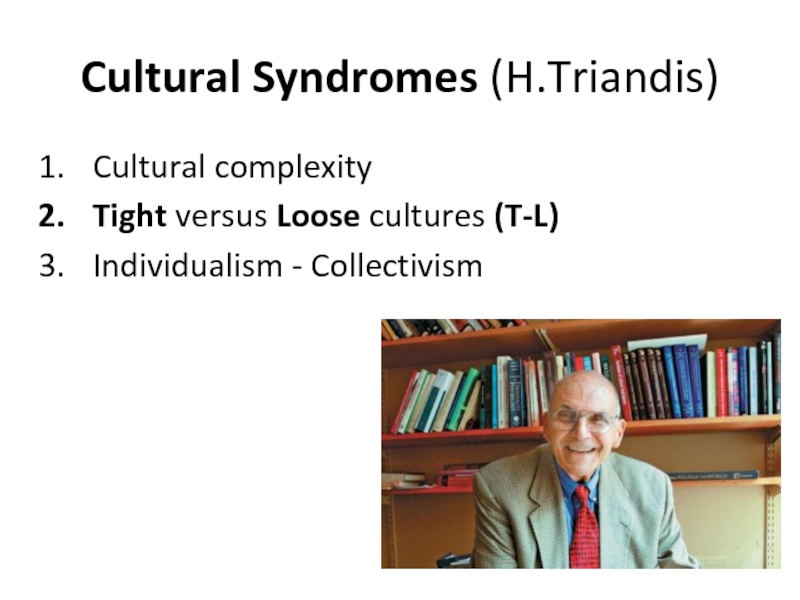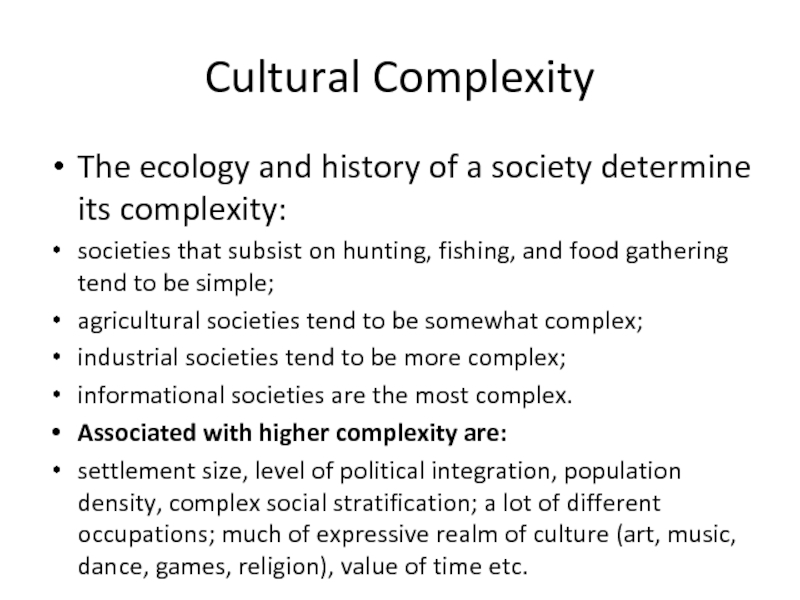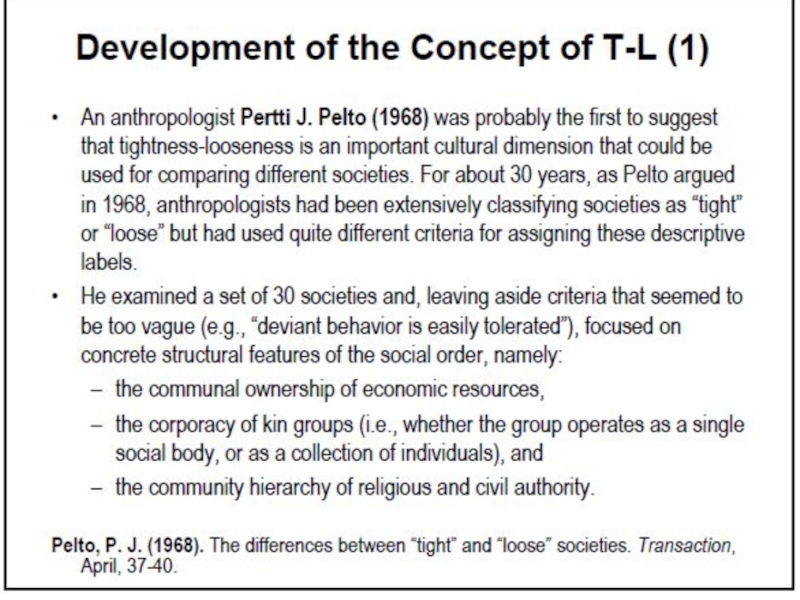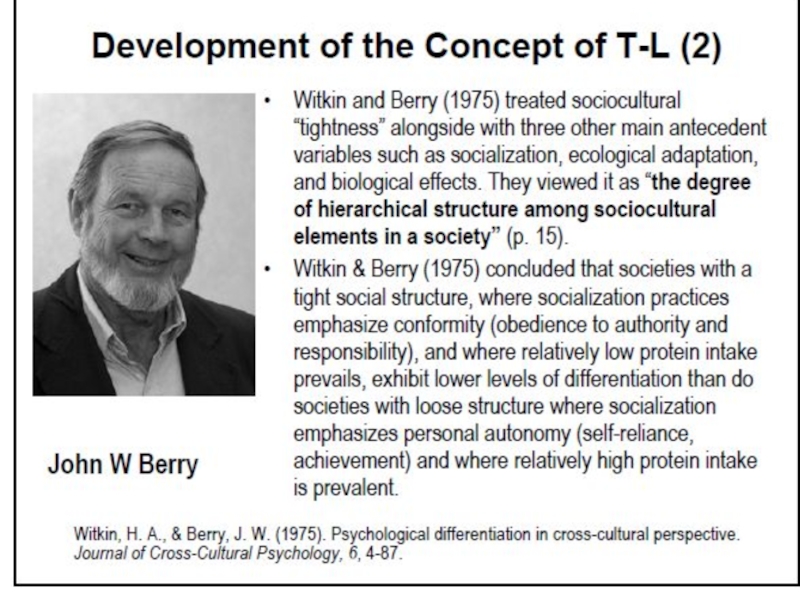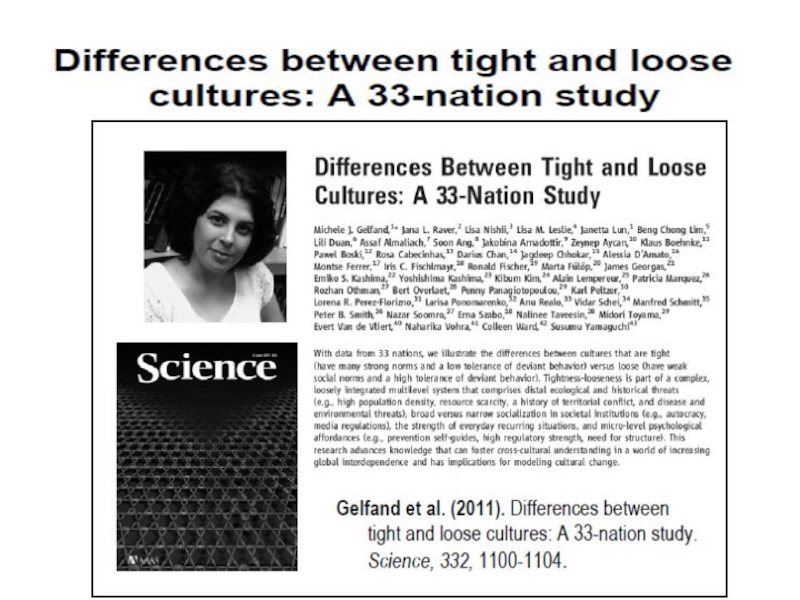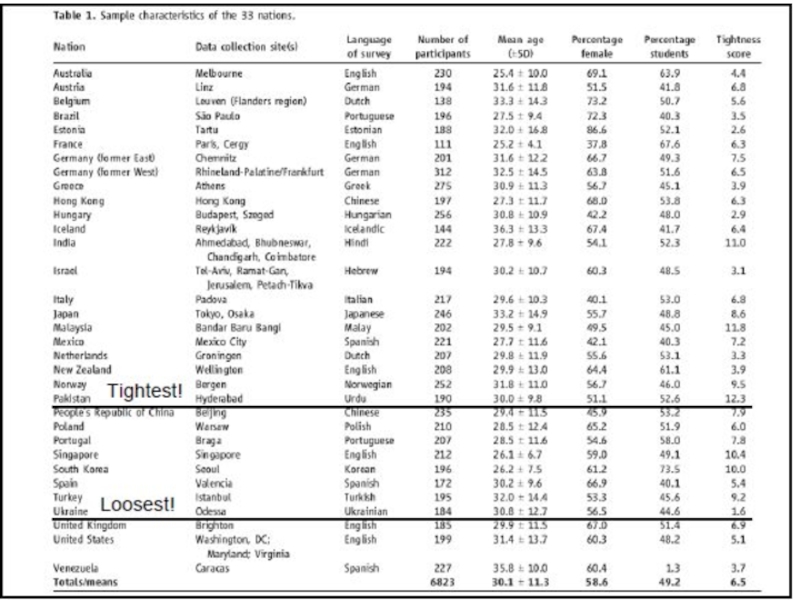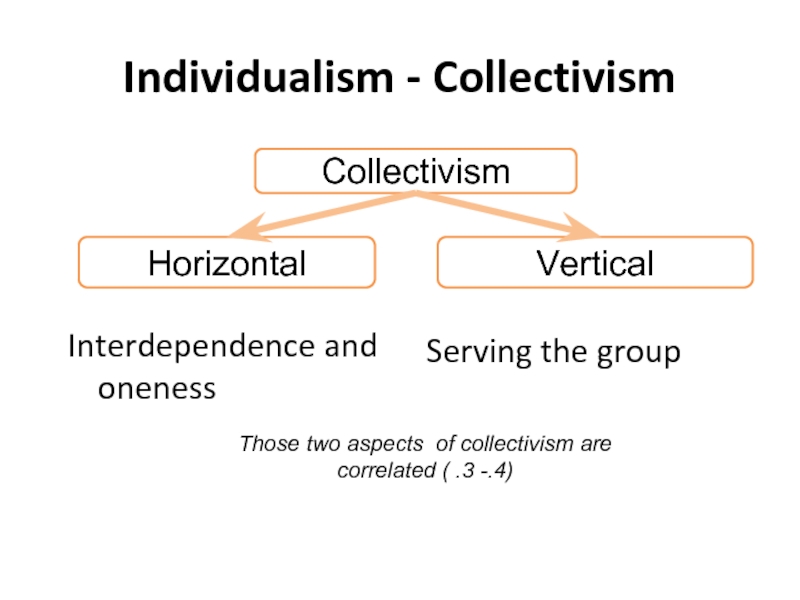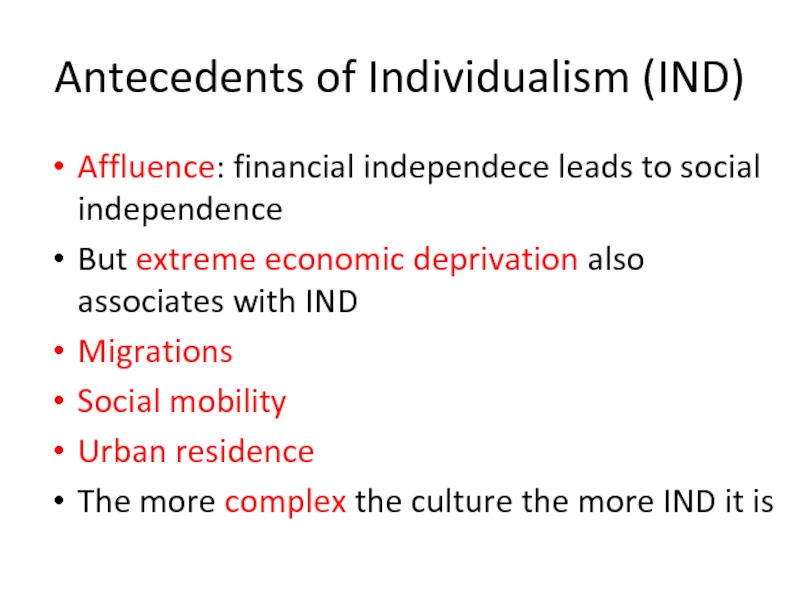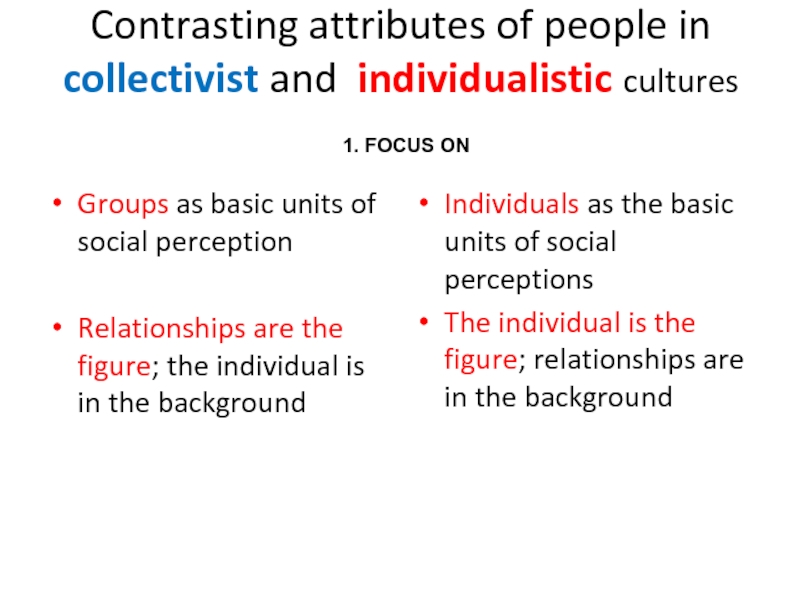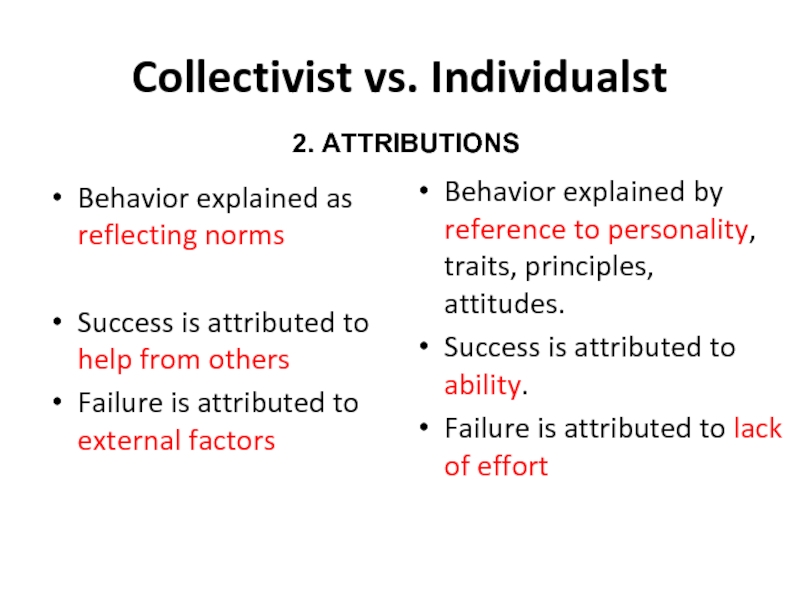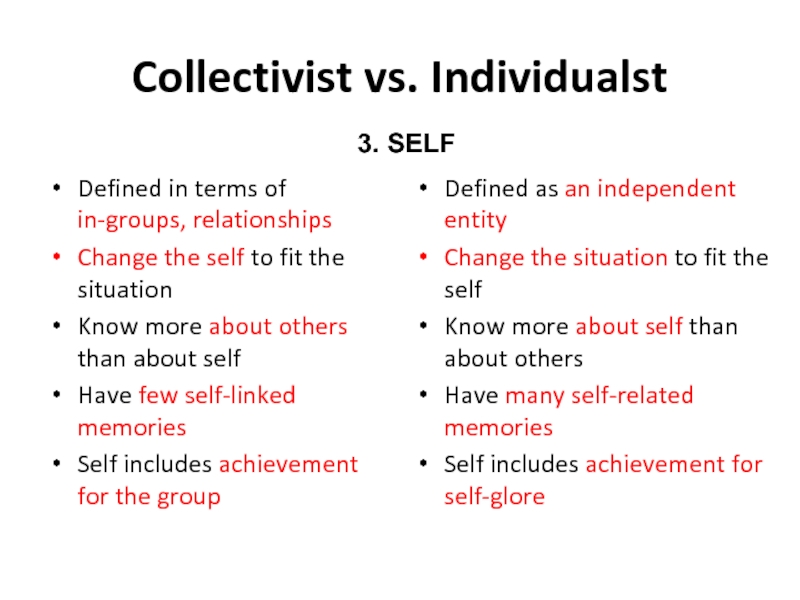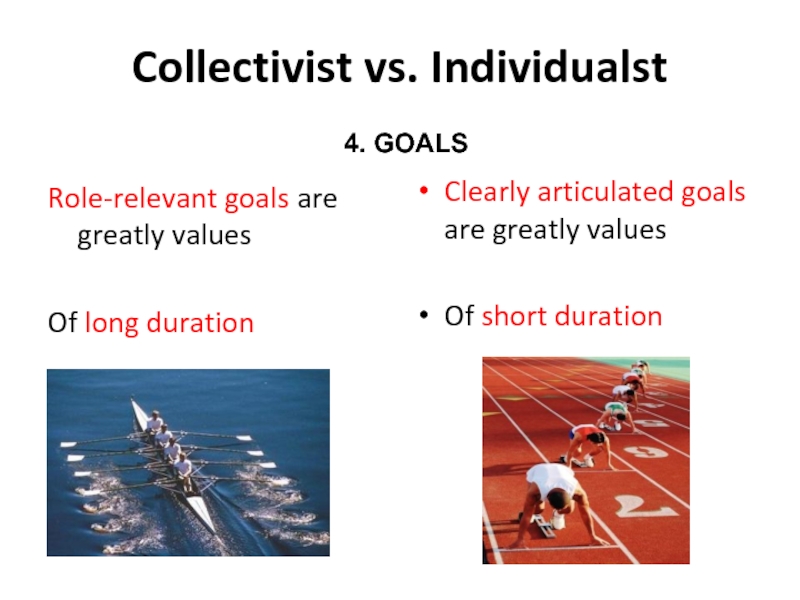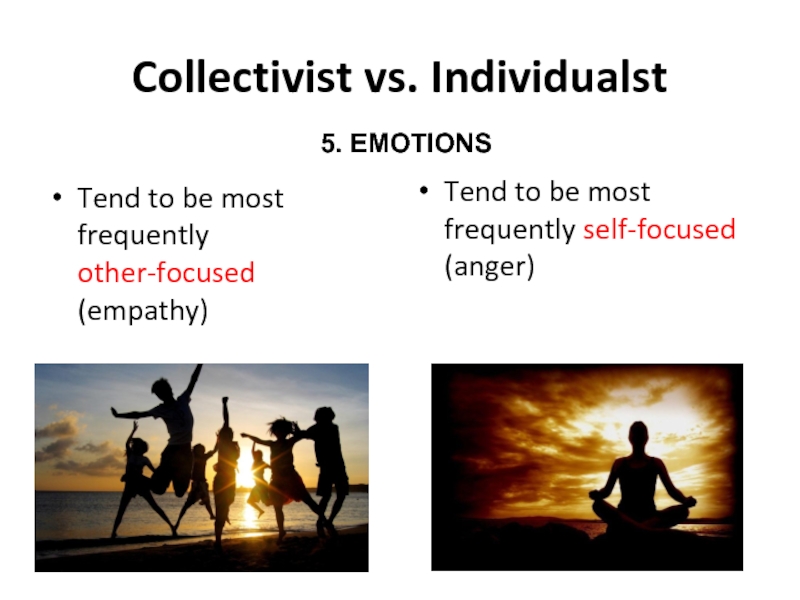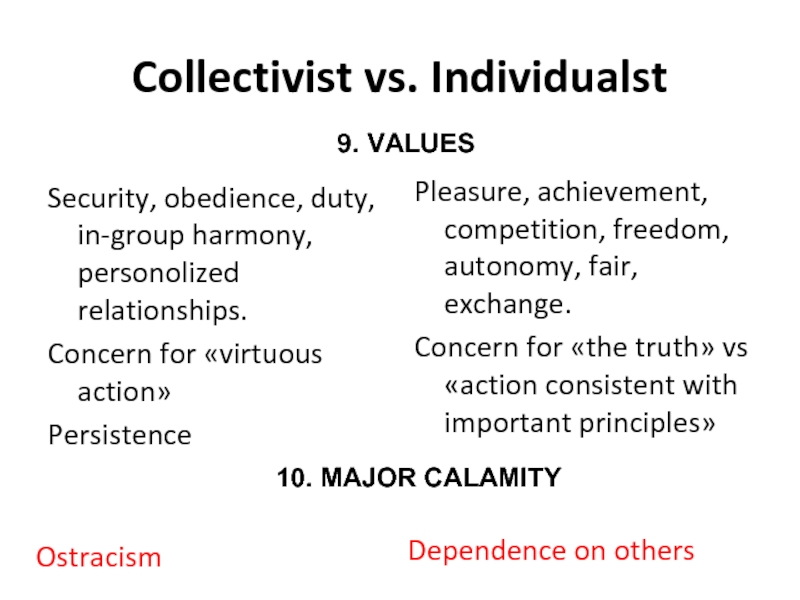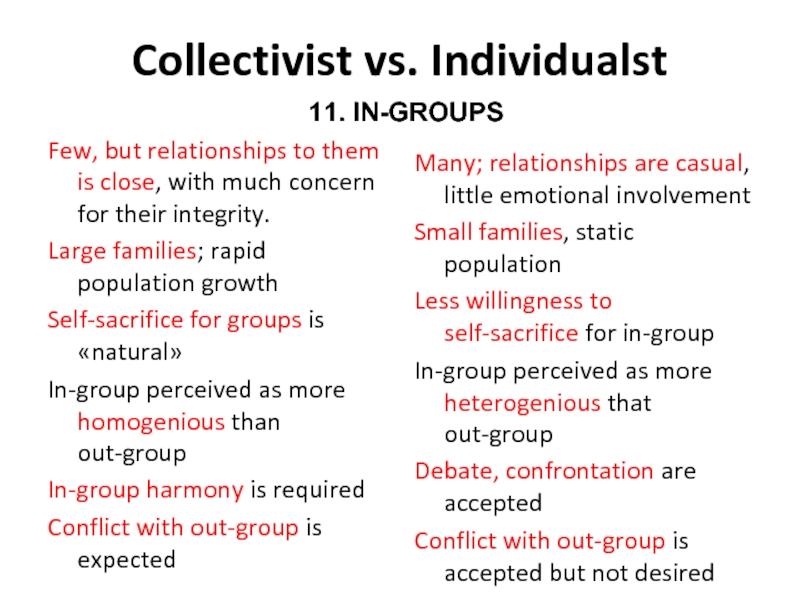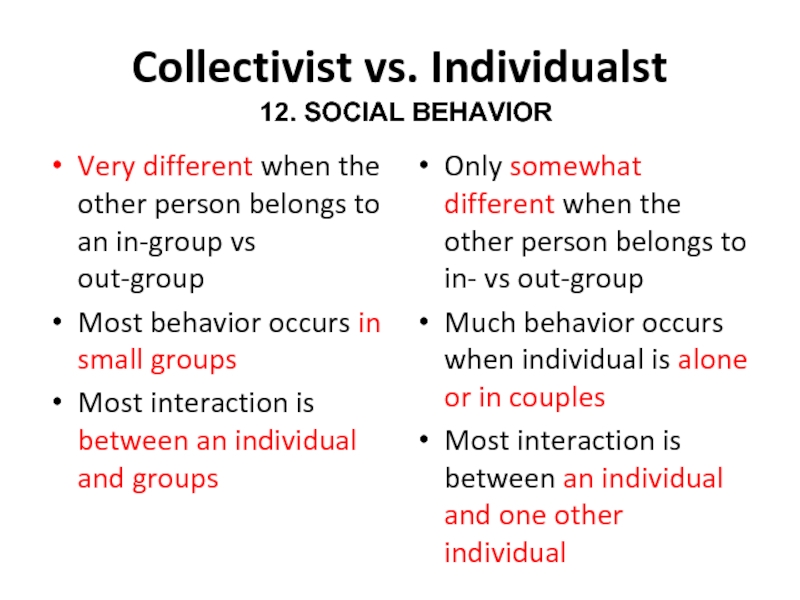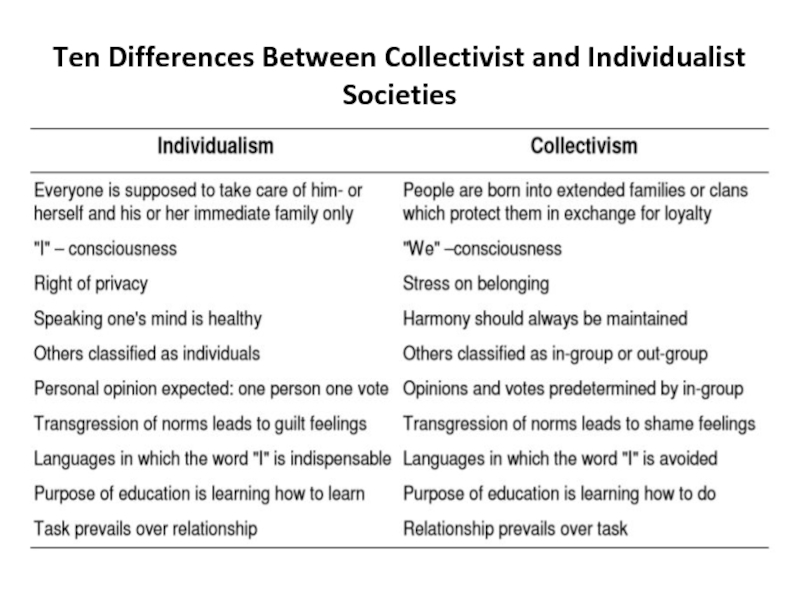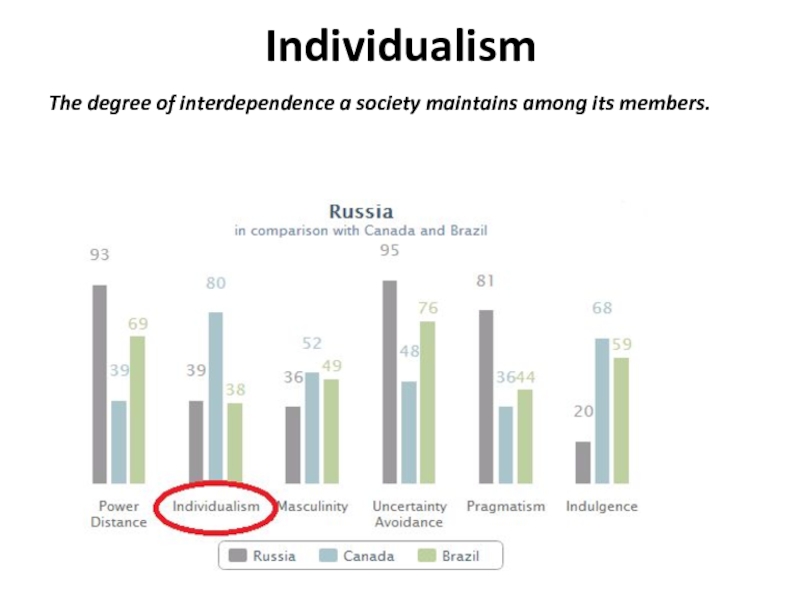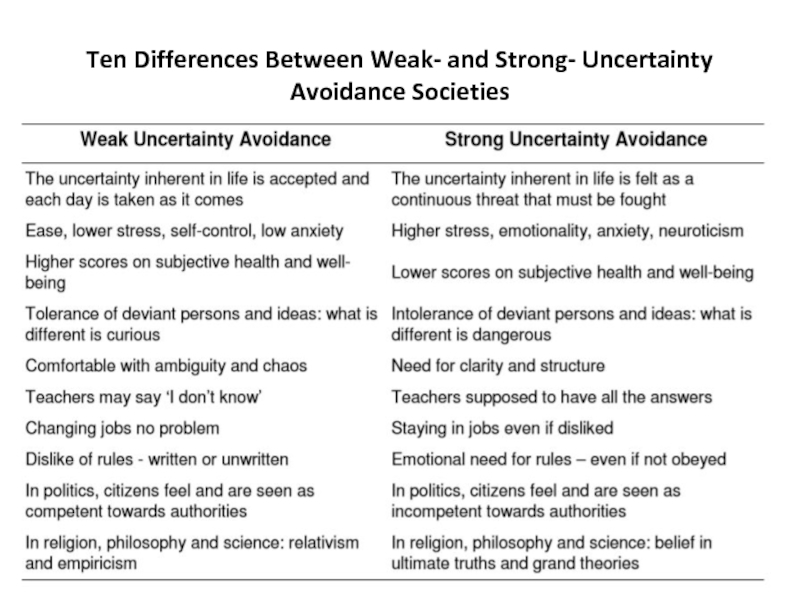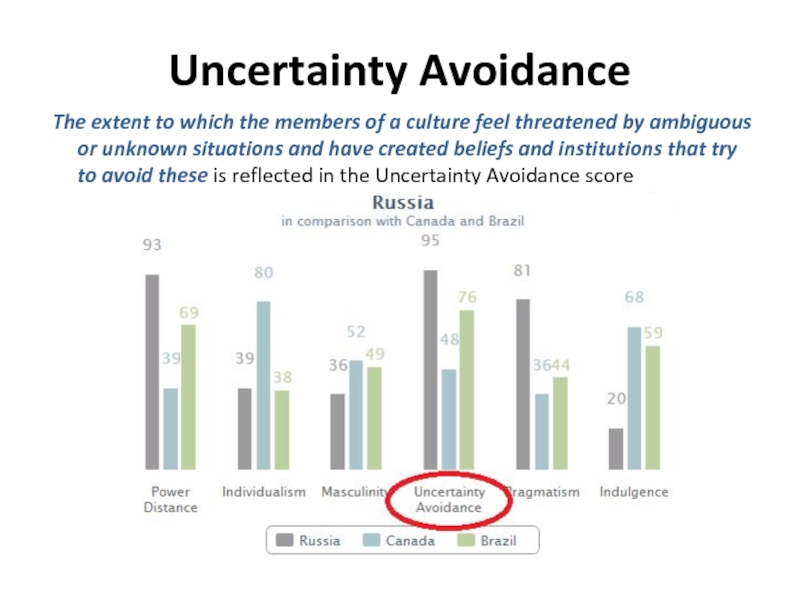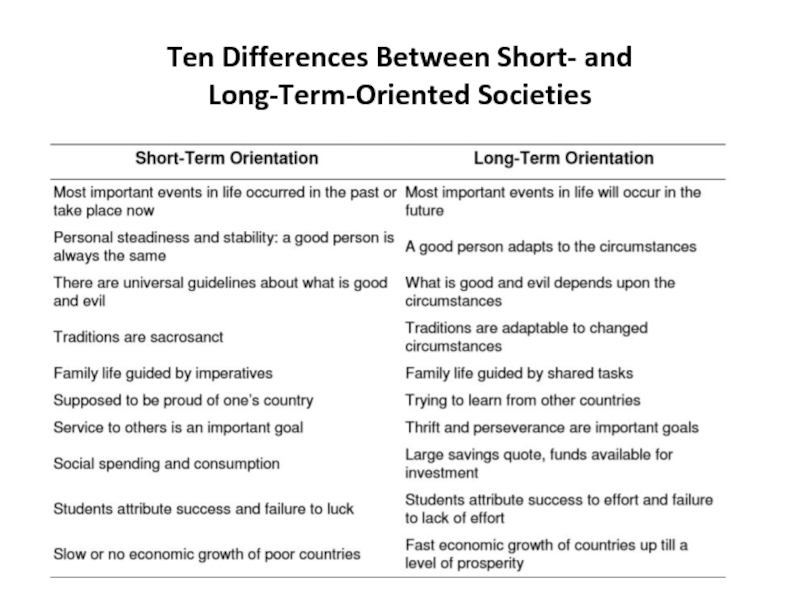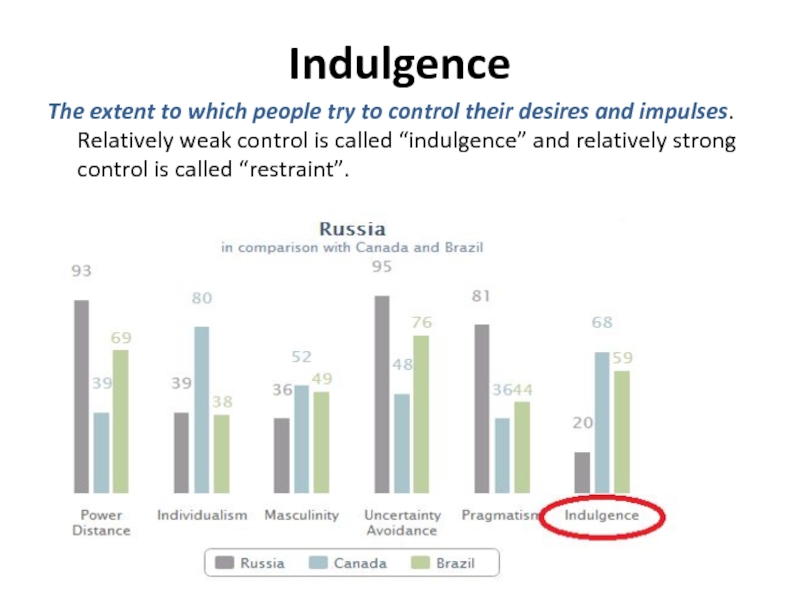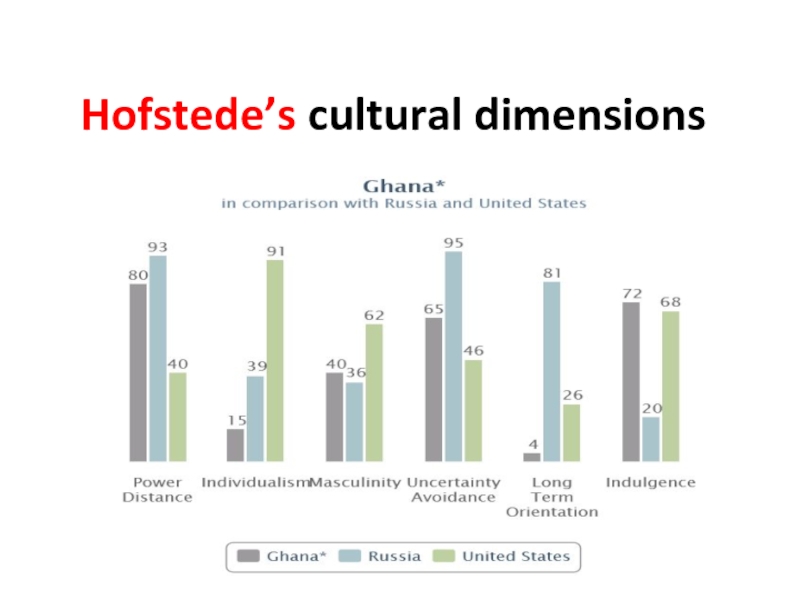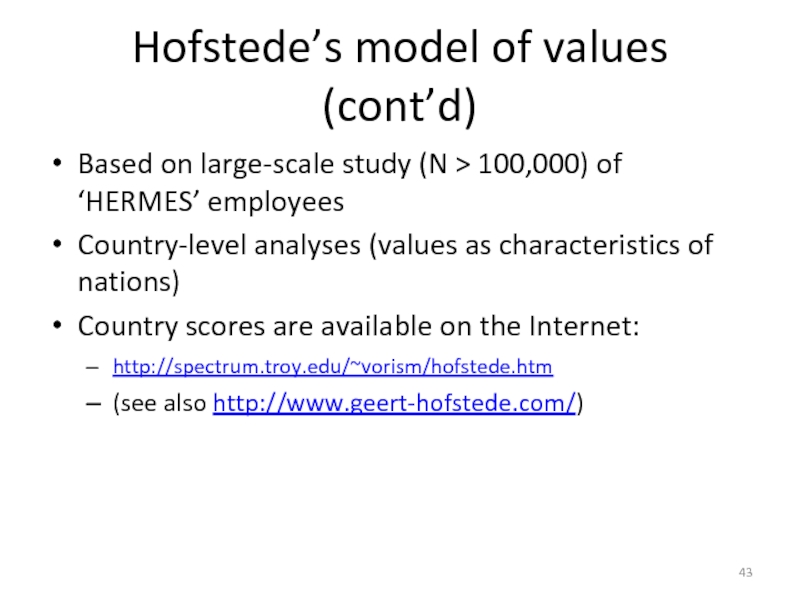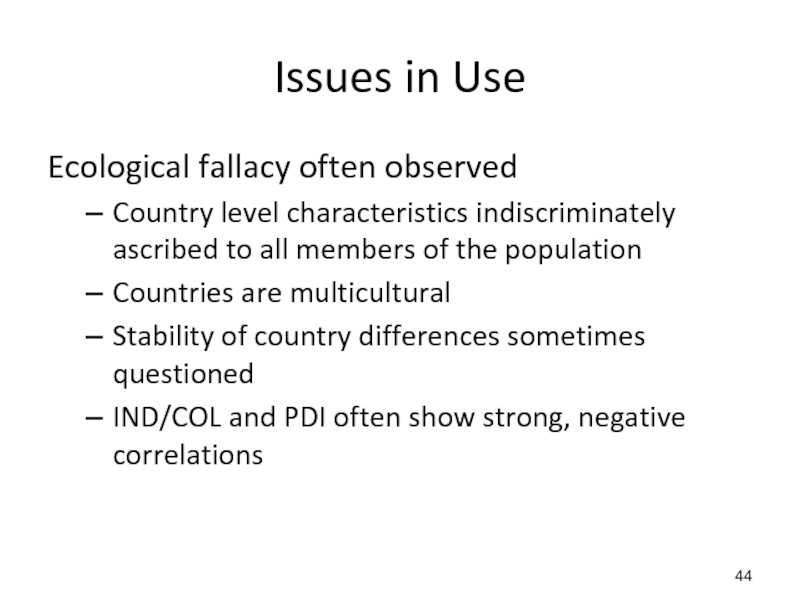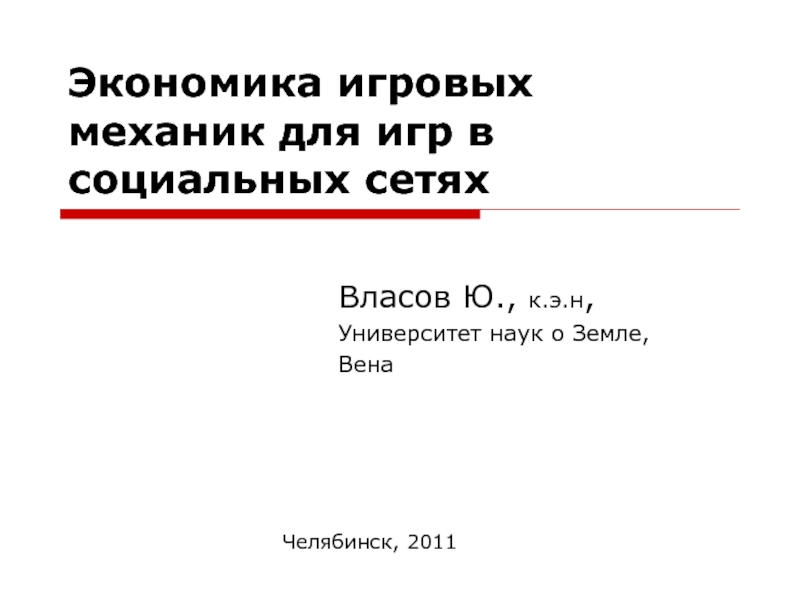- Главная
- Разное
- Дизайн
- Бизнес и предпринимательство
- Аналитика
- Образование
- Развлечения
- Красота и здоровье
- Финансы
- Государство
- Путешествия
- Спорт
- Недвижимость
- Армия
- Графика
- Культурология
- Еда и кулинария
- Лингвистика
- Английский язык
- Астрономия
- Алгебра
- Биология
- География
- Детские презентации
- Информатика
- История
- Литература
- Маркетинг
- Математика
- Медицина
- Менеджмент
- Музыка
- МХК
- Немецкий язык
- ОБЖ
- Обществознание
- Окружающий мир
- Педагогика
- Русский язык
- Технология
- Физика
- Философия
- Химия
- Шаблоны, картинки для презентаций
- Экология
- Экономика
- Юриспруденция
Measuring and mapping 2017 -part 1 презентация
Содержание
- 1. Measuring and mapping 2017 -part 1
- 2. What do “cultural differences” mean? “Culture
- 3. Objective Elements of Culture The objective elements
- 4. Subjective Elements of Culture The subjective elements
- 6. Elementary forms of social behavior (Fiske,
- 7. How to “measure” culture? Harry C. Triandis Geert Hofstede Ronald F. Inglehart Shalom H. Schwartz
- 8. Cultural Syndromes (H.Triandis) Cultural complexity Tight versus Loose cultures (T-L) Individualism - Collectivism
- 9. Cultural Complexity The ecology and history of
- 16. Individualism Priority to personal goals, even if
- 17. Individualism - Collectivism Interdependence and oneness Collectivism
- 18. Antecedents of Individualism (IND) Affluence: financial independece
- 19. Contrasting attributes of people in collectivist and
- 20. Collectivist vs. Individualst Behavior explained as reflecting
- 21. Collectivist vs. Individualst Defined in terms of
- 22. Collectivist vs. Individualst Role-relevant goals are greatly
- 23. Collectivist vs. Individualst Tend to be most
- 24. Collectivist vs. Individualst Focus on the needs
- 25. Collectivist vs. Individualst Favor belifs that reflect
- 26. Collectivist vs. Individualst Security, obedience, duty, in-group
- 27. Collectivist vs. Individualst Few, but relationships to
- 28. Collectivist vs. Individualst Very different when the
- 29. Relations between cultural syndromes
- 30. Hofstede’s cultural dimensions
- 31. Ten Differences Between Small- and Large- Power Distance Societies
- 32. Power Distance Power distance is defined as the
- 33. Ten Differences Between Collectivist and Individualist Societies
- 34. Individualism The degree of interdependence a society maintains among its members.
- 35. Ten Differences Between Feminine and Masculine Societies
- 36. Masculinity A high score (masculine) on this
- 37. Ten Differences Between Weak- and Strong- Uncertainty Avoidance Societies
- 38. Uncertainty Avoidance The extent to which the
- 39. Ten Differences Between Short- and Long-Term-Oriented Societies
- 40. Ten Differences between Indulgent and Restrained Societies
- 41. Indulgence The extent to which people try
- 42. Hofstede’s cultural dimensions
- 43. Hofstede’s model of values (cont’d) Based on
- 44. Issues in Use Ecological fallacy often observed
Слайд 2What do “cultural differences” mean?
“Culture is the collective programming of
Cultural dimensions are value constructs, which can be used to describe a specific culture.
Values are a “desirable transsituational goals, varying in importance, that serve as guiding principles in the life of a person or other social entity” (S. Schwartz)
Слайд 3Objective Elements
of Culture
The objective elements of culture involve objective, explicit elements
These would include architecture, clothes, foods, art, eating utensils, and the like. In today’s world, advertising, texts, architecture, art, mass media, television, music, the Internet, Facebook, and Twitter are all physical, tangible, and important artifacts of culture (Lamoreaux & Morling, in press; Morling & Lamoreaux, 2008).
A recent study actually analyzed millions of digitized books—about 4% of all books ever printed—to investigate cultural trends over time (Michel et al., 2011) and demonstrated changes in vocabularies, grammar, collective memory, the adoption of technology, the pursuit of fame, censorship, and historical epidemiology.
Слайд 4Subjective Elements of Culture
The subjective elements of culture include all those
Слайд 6Elementary forms of social behavior
(Fiske, 1990, 1992)
Communal Sharing (CS) –
Authority ranking (AR) – paying attention to status and divide according to rank
Equality matching (EM) – accent is on equality and equal sharing
Market pricing (MP) – proportionality between you give and receive
Слайд 7How to “measure” culture?
Harry C. Triandis
Geert Hofstede
Ronald F. Inglehart
Shalom H. Schwartz
Слайд 8Cultural Syndromes (H.Triandis)
Cultural complexity
Tight versus Loose cultures (T-L)
Individualism - Collectivism
Слайд 9Cultural Complexity
The ecology and history of a society determine its complexity:
societies
agricultural societies tend to be somewhat complex;
industrial societies tend to be more complex;
informational societies are the most complex.
Associated with higher complexity are:
settlement size, level of political integration, population density, complex social stratification; a lot of different occupations; much of expressive realm of culture (art, music, dance, games, religion), value of time etc.
Слайд 16Individualism
Priority to personal goals, even if they conflict with group goals
Collectivism
Priority
Self is defined in terms of membership in in-groups which influence social behavior
Collectivists tend to :
Be concerned about the results of their actions on in-group
Share resources with in-group
Feel interdependent
Feel involved in the lives of in-group
Слайд 17Individualism - Collectivism
Interdependence and oneness
Collectivism
Horizontal
Vertical
Serving the group
Those two aspects of collectivism
Слайд 18Antecedents of Individualism (IND)
Affluence: financial independece leads to social independence
But extreme
Migrations
Social mobility
Urban residence
The more complex the culture the more IND it is
Слайд 19Contrasting attributes of people in collectivist and individualistic cultures
Groups as basic
Relationships are the figure; the individual is in the background
Individuals as the basic units of social perceptions
The individual is the figure; relationships are in the background
1. FOCUS ON
Слайд 20Collectivist vs. Individualst
Behavior explained as reflecting norms
Success is attributed to help
Failure is attributed to external factors
Behavior explained by reference to personality, traits, principles, attitudes.
Success is attributed to ability.
Failure is attributed to lack of effort
2. ATTRIBUTIONS
Слайд 21Collectivist vs. Individualst
Defined in terms of in-groups, relationships
Change the self to
Know more about others than about self
Have few self-linked memories
Self includes achievement for the group
Defined as an independent entity
Change the situation to fit the self
Know more about self than about others
Have many self-related memories
Self includes achievement for self-glore
3. SELF
Слайд 22Collectivist vs. Individualst
Role-relevant goals are greatly values
Of long duration
Clearly articulated goals
Of short duration
4. GOALS
Слайд 23Collectivist vs. Individualst
Tend to be most frequently other-focused (empathy)
Tend to
5. EMOTIONS
Слайд 24Collectivist vs. Individualst
Focus on the needs of my in-group (obligations)
Cognitions are
Focus on my needs, rights, capacity (contracts)
Cognitions are context independent.
6. COGNITIONS
Слайд 25Collectivist vs. Individualst
Favor belifs that reflect interdependence
Favor beliefs that reflect independence,
7. ATTITUDES
8. NORMS
Favor embededness in in-group
Favor independence from in-group
Слайд 26Collectivist vs. Individualst
Security, obedience, duty, in-group harmony, personolized relationships.
Concern for «virtuous
Persistence
Pleasure, achievement, competition, freedom, autonomy, fair, exchange.
Concern for «the truth» vs «action consistent with important principles»
9. VALUES
10. MAJOR CALAMITY
Ostracism
Dependence on others
Слайд 27Collectivist vs. Individualst
Few, but relationships to them is close, with much
Large families; rapid population growth
Self-sacrifice for groups is «natural»
In-group perceived as more homogenious than out-group
In-group harmony is required
Conflict with out-group is expected
Many; relationships are casual, little emotional involvement
Small families, static population
Less willingness to self-sacrifice for in-group
In-group perceived as more heterogenious that out-group
Debate, confrontation are accepted
Conflict with out-group is accepted but not desired
11. IN-GROUPS
Слайд 28Collectivist vs. Individualst
Very different when the other person belongs to an
Most behavior occurs in small groups
Most interaction is between an individual and groups
Only somewhat different when the other person belongs to in- vs out-group
Much behavior occurs when individual is alone or in couples
Most interaction is between an individual and one other individual
12. SOCIAL BEHAVIOR
Слайд 30 Hofstede’s cultural dimensions
1. Power Distance (different solutions
2. Uncertainty Avoidance (level of stress in a society in the face of an unknown future);
3. Individualism versus Collectivism (integration of individuals into primary groups);
4. Masculinity versus Femininity (division of emotional roles between women and men);
5. Long Term versus Short Term Orientation (focus for people's efforts: the future or the present and past);
6. Indulgence versus Restraint (gratification vs control of basic human desires related to enjoying life).
Слайд 32Power Distance
Power distance is defined as the extent to which the less
Слайд 36Masculinity
A high score (masculine) on this dimension indicates that the society
The fundamental issue here is what motivates people, wanting to be the best (masculine) or liking what you do (feminine).
Слайд 38Uncertainty Avoidance
The extent to which the members of a culture feel
Слайд 41Indulgence
The extent to which people try to control their desires and
Слайд 43Hofstede’s model of values (cont’d)
Based on large-scale study (N > 100,000)
Country-level analyses (values as characteristics of nations)
Country scores are available on the Internet:
http://spectrum.troy.edu/~vorism/hofstede.htm
(see also http://www.geert-hofstede.com/)
Слайд 44Issues in Use
Ecological fallacy often observed
Country level characteristics indiscriminately ascribed to
Countries are multicultural
Stability of country differences sometimes questioned
IND/COL and PDI often show strong, negative correlations
